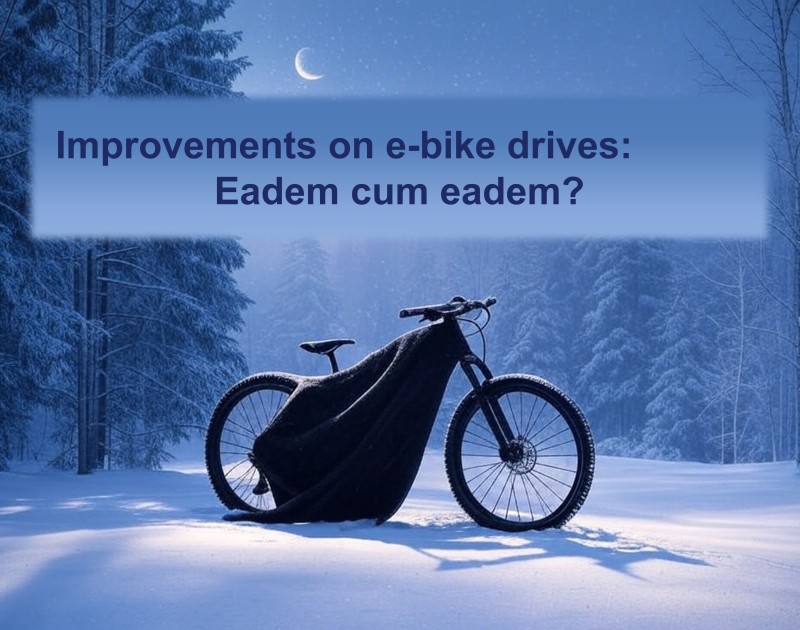New - Concept11 Powershift transmission
1. What can be improved on e-bike drives?
Certainly: more powerful, lighter, less bulky and quieter, so in the end “eadem cum eadem”, which means “the same with the same”!
Or are there other options?
A disruptive approach is to change the nature of the drive train! For example by combining the electric drive and gearshift into a single unit. This approach is not entirely new and first solutions are on the market. Usually, a multi-shaft gearbox consisting of several cylindrical gear stages is combined with an electric motor. By using all available ratios of the gearbox it can provide its power over a wide operating range.
However, the demand of the installation space leads to unfavorable design and increased weight.
Transmissions with planetary gears are known from bicycles and cars, where they can provide a large number of gears in a relatively small installation space with a very high power and functional density.
Can you imagine a solution with planetary gear sets mounted in the limited space around the pedal crank? To benefit from their high functionality and power density?

2. Do e-bike drives need powershifts ?
In the context of transmissions, power-shifting refers to the ability to change the transmission ratio under load without interrupting the power flow.
With derailleur gears in conventional e-bikes, the power (the pedal torque and thus also the drive torque of the electric motor) is reduced during shifting in order to avoid damaging the gears or chain. At this moment, there is a significant drop in torque, which can be very unpleasant in some riding situations, especially when shifting through several gears. Think, for example, of cycling uphill, where the speed quickly becomes very low if no drive power is available.
To shift gears at full power and full torque on the pedal at all times, you need a fully power-shiftable transmission! Regardless of whether you are shifting into smaller or larger gears.
In passenger cars, such power-shift transmissions are known as automatic or dual-clutch transmissions. In recent years, these transmissions have replaced manual transmissions in almost all market segments.
Are there similar prospects of success for power-shifting in e-bike transmissions?

3. Powershift transmission - How does it work?
To shift a gear under load, a new power flow (gear) must be activated by closing a first shifting element, while a second shifting element for the current power flow (gear) must be opened accordingly.
Let’s examine a power shift from a lower to a higher gear (upshift) when accelerating:
The first shifting element must start to transmit torque despite an existing speed difference. This relieves the second shifting element of torque and allows it to be opened. Subsequently, by closing the first shifting element the speeds in the transmission are then fully adjusted to the new gear. The power-shift is completed.
Challenge for upshifts: Close the first shifting element under existing speed difference and open the second shifting element exactly when it’s load-free.
Now let’s examine a power-shift for a higher to a lower gear (downshift) when accelerating:
The shifting element to be opened must be able to be opened under load and immediately allow a speed difference. Exactly when the speeds are adjusted to the lower gear the shifting element to close must take its full load. The power-shift is completed.
Challenge for downshifts: Open the first shifting element under load and close the second shifting element precisely when its speed difference is reduced to zero.
Can such a mechanism be transferred to a bicycle transmission in a simple way?

4. How do you create complex gearbox structures?
Power-shiftable and with planetary gears?
Applicable in e-bike drives?
Gear synthesis is generally understood to be the development process for a gearbox structure that fulfils specific requirements. For e-bike drives, these are demanded gear ratios, available installation space, efficiency requirements, etc. and, above all, power-shift capability.
For gearboxes with multiple gears and with involved planetary stages the task of synthesis can soon become very complex. For this reason, there are a handful of computer-aided synthesis programs worldwide that systematically generate and evaluate all possible transmission structures.
At MAHLE Powertrain, the PlanGear synthesis programme has been developed and used for any systematic gearbox synthesis. Among other things, PlanGear can calculate various types of power-shift transmissions.
PlanGear is based on a so-called lever analogy model. This enables us to synthesize not only simple planetary gearboxes, but also so-called complex compound planetary gearsets (such as the Ravigneaux or Wolfrom set), and massively minimizes the calculation time for many complex gearbox structures.
See associated papers:
Gear synthesis program of ZG GmbH [PDF; 895 KB]
Synthesis & functionalities of multi-clutch transmissions [PDF; 1945 KB]
In an internal study, MAHLE Powertrain has investigated what future e-bike drives with planetary gearboxes arranged coaxially to the pedal crank could look like, making a large number of gears fully power shiftable.

5. Ingredients for a powershift e-bike drive
Task: Find a gearbox structure consisting of planetary gear sets arranged coaxially around the crankshaft. The planetary gear sets must be connected via shifting elements and shafts in such a way that the required ratios are achieved.
E-bike drives only transmit power in one direction. For this reason, freewheels can also be used as shifting elements in some cases. These only allow relative movements in one direction.
Brakes are clutches where one side is connected to the housing. Brakes are therefore generally simpler in design than clutches. For this reason, brakes should be the shift elements that enable all powershifting. These are the so-called power-shiftable brakes.
Dog clutches can only be shifted without a load. Similar to the dual clutch transmission, they are used to preselect the gears. The actual shifting process takes place via the power-shiftable brakes.
MAHLE Powertrains’ synthesis program PlanGear is fed with these “ingredients” to find systematically and automatically suitable gear structures.

6. Principle & example of a power-shifting e-bike transmission
MAHLE Powertrain’s PlanGear synthesis programme has generated a large number of transmission structures for possible power-shiftable bicycle transmissions.
The video below shows an example of the principle of operation. (Scroll down if necessary).
Two dedicated shifting elements in the form of power-shiftable brakes with an integrated freewheel are used to shift through the 7 speeds of the transmission without interrupting the torque.
To do this, a pre-selection for the next gear is made in the current gear, as in the operation of a dual clutch transmission. This is done by shifting dog clutches, which are only engaged or disengaged without load. A corresponding overlap of the load-shifting elements results in a torque-interruption-free gear change.
For more details see also:
Synthesis & functionalities of multi-clutch transmissions [PDF; 1945 KB]
The 7 speeds of the transmission can be realised with 3 planetary gear sets, a complex compound gear set and two simple epicyclic gears. These can be conveniently arranged inline with the crankshaft, resulting in very favourable packaging of the entire drive unit.
The electric motor acts directly on the crankshaft via a suitable transmission ratio and thus fully utilises the gearbox. Overall, this example shows that a powershift transmission can be integrated into the installation space of an e-bike drive unit in a very space-saving manner.
A fully power-shiftable transmission with 11 gears is now under development.
Scroll down for the explainer video.

7. Concept11: 11-Speed Power-Shiftable E-Bike Unit
Concept11 stands for an e-bike drive that combines a powerful e-drive with an 11-speed transmission with full power-shift capability. Gear selection can be fully automatic, e.g. based on a preset cadence, or manual via shift paddles.
The electric motor utilises all the gears of the transmission and does not need to reduce power even during shifting. This means that the full electric drive power, supplemented by the driver's power, is available at all times, even during an upshift or downshift.
Concept11 relies on a transmission structure in which planetary gears are arranged inline with the crankshaft. The high power density of planetary gears on the one hand and the space-saving arrangement on the other result in an extremely compact electric drive unit that can be perfectly integrated into the bicycle frame.
Powershift - Principle & Example (Video)

Transmissions - Design, Development & Prototyping
Follow this link for more details on our comprehensive capabilities in the design, modelling, analysis, testing, optimisation and prototyping of gears and transmission systems.
